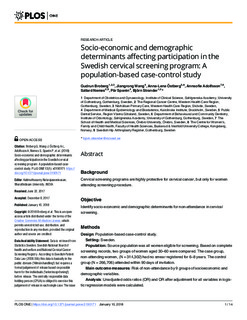| dc.contributor.author | Broberg, Gudrun | |
| dc.contributor.author | Wang, Jiangrong | |
| dc.contributor.author | Ôstberg, Anna-Lena | |
| dc.contributor.author | Adolfsson, Annsofie | |
| dc.contributor.author | Nemes, Szilard | |
| dc.contributor.author | Sparén, Pär | |
| dc.contributor.author | Strander, Björn | |
| dc.date.accessioned | 2019-01-30T09:58:14Z | |
| dc.date.available | 2019-01-30T09:58:14Z | |
| dc.date.created | 2018-11-29T15:08:45Z | |
| dc.date.issued | 2018 | |
| dc.identifier.citation | PLoS ONE. 2018, 13(1). | nb_NO |
| dc.identifier.issn | 1932-6203 | |
| dc.identifier.uri | http://hdl.handle.net/11250/2583025 | |
| dc.description | This is an open access article distributed under the terms of the Creative Commons Attribution License, which permits unrestricted use, distribution, and reproduction in any medium, provided the original author and source are credited. | nb_NO |
| dc.description.abstract | Background
Cervical screening programs are highly protective for cervical cancer, but only for women attending screening procedure.
Objective
Identify socio-economic and demographic determinants for non-attendance in cervical screening.
Methods
Design: Population-based case-control study.
Setting: Sweden.
Population: Source population was all women eligible for screening. Based on complete screening records, two groups of women aged 30–60 were compared. The case group, non-attending women, (N = 314,302) had no smear registered for 6–8 years. The control group (N = 266,706) attended within 90 days of invitation.
Main outcome measures: Risk of non-attendance by 9 groups of socioeconomic and demographic variables.
Analysis: Unadjusted odds ratios (OR) and OR after adjustment for all variables in logistic regression models were calculated.
Results
Women with low disposable family income (adjOR 2.06; 95% confidence interval (CI) 2.01–2.11), with low education (adjOR 1.77; CI 1.73–1.81) and not cohabiting (adjOR 1.47; CI 1.45–1.50) were more likely to not attend cervical screening. Other important factors for non-attendance were being outside the labour force and receiving welfare benefits. Swedish counties are responsible for running screening programs; adjusted OR for non-participation in counties ranged from OR 4.21 (CI 4.06–4.35) to OR 0.54 (CI 0.52–0.57), compared to the reference county. Being born outside Sweden was a risk factor for non-attendance in the unadjusted analysis but this disappeared in certain large groups after adjustment for socioeconomic factors.
Conclusion
County of residence and socio-economic factors were strongly associated with lower attendance in cervical screening, while being born in another country was of less importance. This indicates considerable potential for improvement of cervical screening attendance in several areas if best practice of routines is adopted. | nb_NO |
| dc.language.iso | eng | nb_NO |
| dc.rights | Navngivelse 4.0 Internasjonal | * |
| dc.rights.uri | http://creativecommons.org/licenses/by/4.0/deed.no | * |
| dc.title | Socio-economic and demographic determinants affecting participation in the Swedish cervical screening program: A population-based case-control study | nb_NO |
| dc.type | Journal article | nb_NO |
| dc.type | Peer reviewed | nb_NO |
| dc.description.version | publishedVersion | nb_NO |
| dc.rights.holder | © 2018 Broberg et al. | nb_NO |
| dc.source.volume | 13 | nb_NO |
| dc.source.journal | PLoS ONE | nb_NO |
| dc.source.issue | 1 | nb_NO |
| dc.identifier.doi | 10.1371/journal.pone.0190171 | |
| dc.identifier.cristin | 1637073 | |
| cristin.unitcode | 222,56,1,0 | |
| cristin.unitname | Institutt for sykepleie- og helsevitenskap | |
| cristin.ispublished | true | |
| cristin.fulltext | original | |
| cristin.qualitycode | 1 | |

